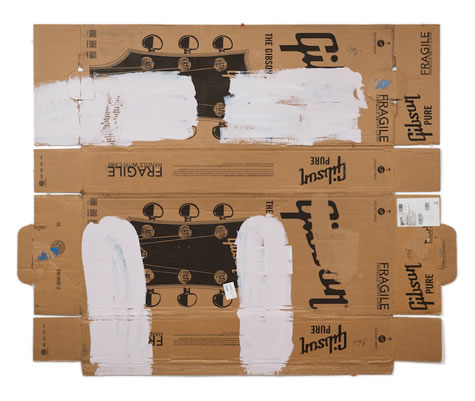Artist George Negroponte is about process. After almost four decades of making art, his work can be viewed in three distinct phases with the commitment to abstraction the essential connection across all. Born and raised in NYC, George Negroponte studied art at Yale with Bernie Chaet and William Bailey. His work is held in the collections of numerous museums, including the Metropolitan Museum of Art, and he has exhibited extensively in New York City and internationally since 1977.
Negroponte has lived and worked in New York City, Stockholm, Sweden and most recently East Hampton, N.Y. Each place has impacted his art with significant changes resulting from influences discovered in each relocation. Today, he lives in Springs with his three children and his wife, the artist Virva Hinnemo. They share adjacent studios in their home set deep in the woods outside of East Hampton Village in The Hamptons.
On the eve of a solo exhibition of recent paintings at Anita Rogers Gallery in New York, Pat Rogers of Hamptons Art Hub reconnected with Negroponte to continue a discussion on his art and his process that began a year ago. Taken together, the interviews reveal the ways the winds of change manifest in his art as examined on the eve of two separate and significant shows—one held in The Hamptons in 2015 and the other in New York City in 2016. Presented as a cohesive whole, the first conversation explores work Negroponte created during an extended period of considerable reevaluation. The second conversation picks up a year later to explore new influences and discuss the latest paintings made by Negroponte in the last year.
The conversation between Negroponte and Rogers begins in Fall 2015.
Pat Rogers: George, you are about to have an exhibit with your wife Virva Hinnemo at Ille Arts in Amagansett in a show titled “Things In Themselves.” Please say something about this new body of work and how you arrived at these particular conclusions.
George Negroponte: It’s a long story because so much of this work started five or six years ago in Sweden; it’s just gone on and on during a period when I’ve seriously questioned my own definition of painting. Time ran away from me. It's been arduous and difficult but happily I’ve realized that I want and need my work to be grounded in the physical—so at least I found something I can depend on.
.
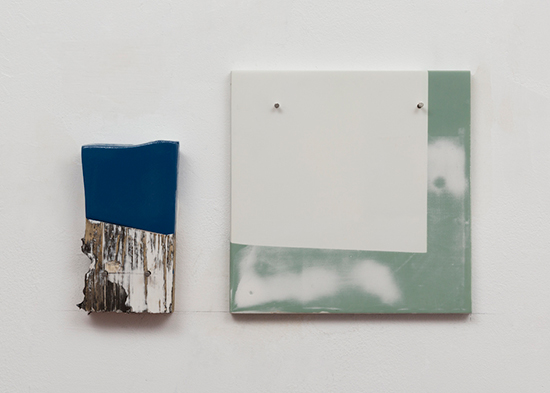
"Pedestrian IV" by George Negroponte, 2012-15. Enamel, house paint and spackle on wood 12 ½ x 8 inches.
.
PR: The new work is a carryover from the prior series, which seems to have arisen from your time in Sweden. Also, can you tell me more about the Omega Workshop that you mentioned in your writing from that period?
GN: The Omega Workshop was created at the turn of the last century and based in England. It was essentially the English version of the Bauhaus. The cultural implications of Omega were substantial because the visual and the political were joined in a revolutionary moment. My arrival in Sweden was very different because I was running away from a failure of mine at Ground Zero—but that’s a very different story. But when I arrived in Sweden I couldn't help but be fascinated by their design.
In my studio at that time I devised a kind of game or distraction for myself: I recalled that Josef Albers would ask his students to take two black shapes of paper and then find the right place for each of them in a rectangle. He insisted there was a “right place”! Remarkably Albers and his students would then endlessly evaluate the “correctness” of their decisions. I was after something a little different because more than anything I wanted to shake up my own sense of form, of drawing, of composition and pare myself down to one or two very basic choices. I reduced the physical elements of my work to virtually nothing and, by the way, I used wallpaper because it offered up all the color I needed and it was ready-made.
.

"Untitled" by George Negroponte. Wallpaper and paper on wood, 15 1/4 by 25 inches.
.
PR: I'd like to take a step even further back, to the first body of work when you were working in the ’70s. These pieces seem to be a very different kind of abstraction, maybe connected more to abstract expressionism. Do you feel that's accurate?
GN: Yes. When I first got back to New York in the mid-’70s I was very drawn to romantic and lyrical painting and Rothko was clearly a huge influence. But so was Ad Reinhardt because his work was so reductive and essential. I managed to put together a way of painting that meant something to me; I was making very large, atmospheric paintings with a small brush. I liked this way of working because it kept me involved in a process of painting all day long. It sounds simple but what I mean is that this degree of involvement drew me in, focused me and directed my energies. Over time, I mean many years, the brush got bigger and bigger until I felt locked out of my own experience.
During that same time I had started working on paper, doing something quite different: I was making marks, I was tearing up pieces of paper, I was moving paint from one drawing to the next, I'd use a roller, I'd use a paint brush. It was a new way forward. Agnes Martin and Robert Motherwell spoke so well about this aspect of creativity: that this kind of intense involvement or absorption in one’s work counts a lot because you are pushed to move beyond yourself, beyond what you know.
.
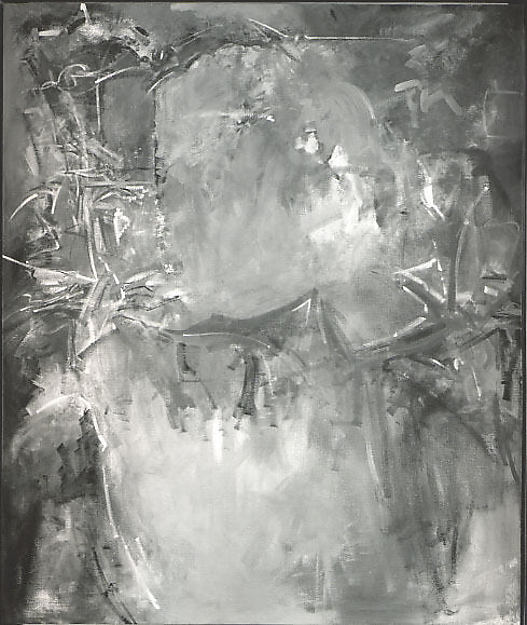
"P. D." by George Negroponte, 1988. Oil on canvas, 72 x 60 inches. Purchase, Pinewood Foundation Gift, 1988. Accession Number 1988.347, Collection of the Metropolitan Museum of Art.
.
PR: One thing that struck me when I was trying to piece together a sense of how you moved from one body of work to the next is there was a change of geography between series. You moved from New York to Scandinavia and then in 2012 you moved here to Springs in East Hampton. Do you feel that the change in locale impacted your work in any way?
GN: Of course these changes are dramatic and there’s a lot of upheaval. Here in Springs I’ve moved into Jackson Pollock’s backyard. Yikes, you can’t cut corners in this neighborhood. There are essential values that have been established here by extraordinary painters and sculptors. At first I struggled to find something to latch onto here. I felt pretty lost. While I walked my dogs in the woods I noticed that all the trails were marked with these white or blue signs made with a single brush mark, placed at eye-level on trees! I started imagining that these signs were beautiful paintings and I envied them and, at the very least, I finally had a source or a starting point.
.
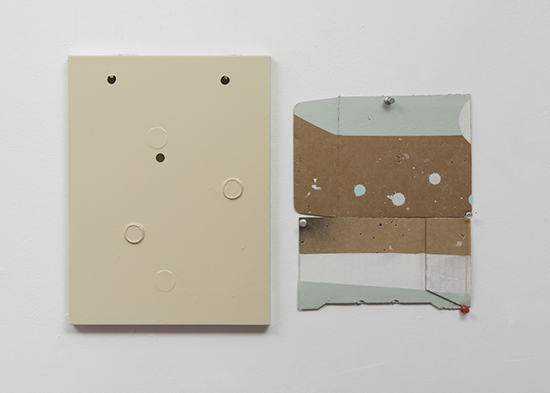
"Pedestrian II" by George Negroponte, 2012-15. Enamel, gouache and spackle on wood and cardboard 12 x 17 ½ inches.
.
PR: Do you think that your work has grown closer to Virva’s? Specifically I mean in the way that you're approaching drawing in your work?
GN: I can’t tell. It’s amazing. Virva’s work is always present and on my mind. By nature we are different because she can work so explosively and with an immediacy that for me is out of reach. I don’t have Virva’s gifted hand or touch and most of the time I feel that by comparison I’m applying paint with a trowel or a shovel. I know I’ve said to her that I paint like a farmer and she paints like an angel. But we share a lot, too. We believe in the language of painting and that the fundamental experience of making art is real and can even at times be profound. We both believe that making art is essentially about generosity and humanity.
.
.
PR: At the beginning of our conversation you started talking about how different the creation of this work was, and how looking at your work in this room represents four to five years worth of exploration and of finding your own way into something that ended up being very new but essentially connected to your past.
GN: One never knows the outcome. A couple of years ago I reached a point when I was determined to bring something absolutely new to my work but I couldn’t figure out what it would look like. If it meant turning my back on a career, fine. If it meant turning my back on the art world, fine. But I knew I wasn’t going to put another thing into the world that I didn’t think should be there. I took a very weighty stand with myself.
.
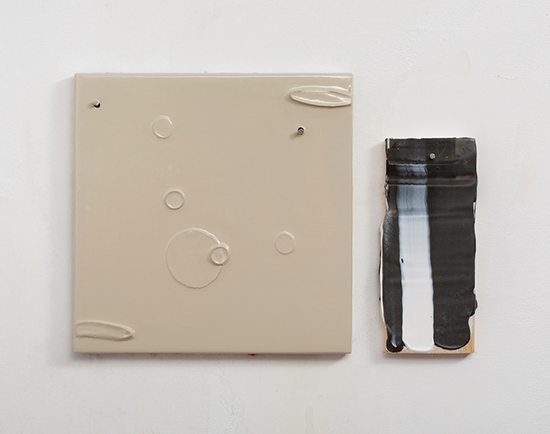
"Here" by George Negroponte, 2012-15. Enamel, spackle and acrylic on wood 8 x 11 ½ inches.
.
PR: As you sit here looking around this new body of work as it's about to go into the gallery [ILLE Arts] and be seen by the public for the first time, what are you thinking? Do you feel "If only I had done one more thing, it would be perfect?" Or, do you feel like "Thank goodness; it's done"?
GN: No, no, I hope I have more perspective. What do I think? I’m happy to have something to show for myself. It’s been awhile since I’ve had feedback and it’s always interesting to see how people respond. There are other aspects of going public that never really change and you find yourself expecting stuff and craving for something. It’s also a gamble, a risk I’ve taken a number of times but I’m still here, still standing.
.
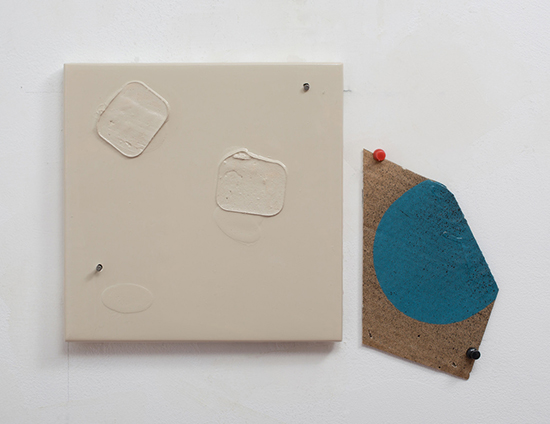
"Now" by George Negroponte, 2012-15. Enamel and spackle on wood and cardboard 8 x 12 ½ inches.
.
PR: I can't help but think there's a transformation here.
GN: I hope so and maybe I had to leave New York to discover something uniquely mine? There is a tendency in NYC to feel everyone is looking over your shoulder. In the most recent book about Agnes Martin by Nancy Princenthal, Agnes Martin talks a lot about “turning her back” on NYC. I left New York in 2007 and I must admit it’s been a bumpy ride. It’s really hard to get that stuff out of your system because you can’t help thinking that in NYC you’re actually at the center of the universe. You probably are at the center. Here in East Hampton I’m isolated and exempt from almost any or all critical dialogue about painting. Most of my discussions are with myself or with Virva. Thankfully I have Virva.
.
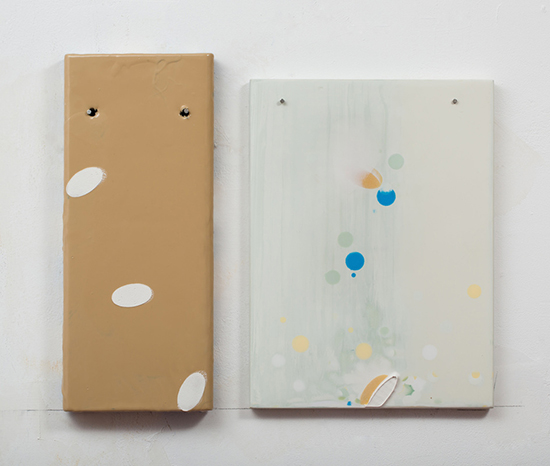
"1968 (Poons)" by George Negroponte, 2012-15. Enamel, house paint and spackle on wood 13 x 16 inches.
.
PR: Is there something that you feel is resolved for you in this recent work?
GN: I think I may have recaptured a more solid sense of subject. Artists always hope they can reach that moment where there’s a sufficient amount of traction that their work simply takes off. But it’s hard not to describe my last five years as anything but excruciatingly difficult. But who knows? Maybe I can ease up on myself a little?
.
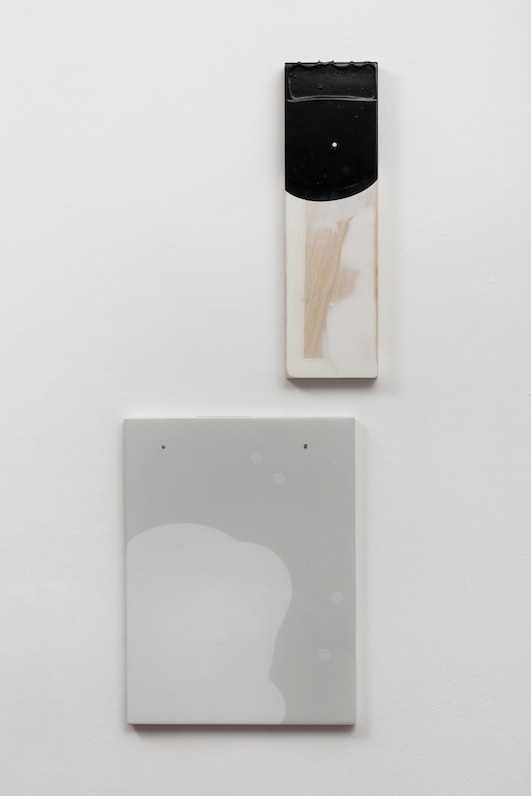
"Pedestrian III" by George Negroponte, 2012-15. Enamel, house paint and spackle on wood 26 x 10 inches.
.
PR: The new works are always presented in pairs. In rare cases, they’re two boards of some kind of wood, but in many cases, there’s a cardboard material and then there’s a wood panel. Could you just talk a little bit about that decision?
GN: The pairings are completely subjective. Sometimes I like making contrasts or creating disruptions and other times I look to make them more fluid. For the most part, I would like to make the pairings a challenge. I might even say subversive because the choices I’m making seem at odds with most conventions I know.
PR: Because the relationship and the jarring is part of the piece. The negative space that’s created both inside the pairings and around them is important. It’s part of the dialogue. The pieces speak very, very intently to one another and as a single piece as well.
GN: Maybe recklessly, too, because of my commitment to the pairings. I suspect my real ambition is to make a single piece again. But as an identical twin, I’m working through a lot of issues about what single and double mean. Interestingly this upcoming exhibit at Ille Arts with Virva touches on that very same problem. My tendency to look for the “other” is pretty stunning, most likely stubborn and even nutty.
.
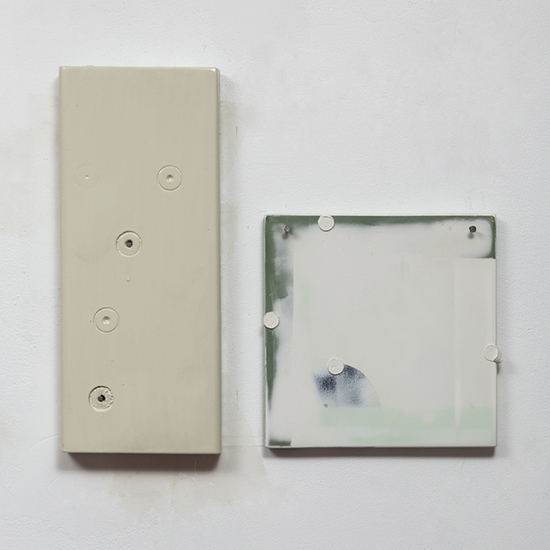
"Pedestrian VI" by George Negroponte, 2012-15. Enamel, house paint and spackle on wood 15 x 13 inches.
.
In October 2016, the discussion continued on the eve of a solo exhibition opening at Anita Rogers Gallery in New York City.
PR: Here we are about 11 months later and a solo exhibit of your work opens at Anita Rogers Gallery in the middle of October. Can you tell me a little about the most recent work? Has your work evolved in the way you might have expected?
GN: Gosh, I’ve come to expect very little but I’m grateful my work has continued to move forward. A lot of the issues we discussed last October still feel very current and relevant. I’m on a much better track these days and I sense more of a steadiness and stability in the studio. Most of these new works happened virtually on their own terms. I stepped aside.
PR: What do you think accounts for the change in perspective?
GN: Well, imagine taking 10 years to get home and I hope that sounds familiar. My roots are from the island of Ithaca so I imagine Odysseus may have played a role in my story, too. But in hindsight I should say that making art is really hard. Franz Kline once said it’s like waking up in the morning and finding your arms stuck in the mattress. Making art requires insights that are altogether of a different kind, like needing to see better, hear better, and probably live better. And more than anything needing to know how to receive. This probably requires a sense of balance I can’t account for.
PR: It sounds tough. What do you feel is the most significant change in the new work?
GN: I made singular works that stand on their own. I took the paired panels and superimposed them on each other. Now they stand on their own and it feels like a declaration of independence.
.

"Gravel Road" by George Negroponte, 2016. Enamel and latex on cardboard, 18.5 x 7 inches. Courtesy Anita Rogers Gallery.
.
PR: That is a change. Have your inspirations changed since we spoke last year? In essays written for your exhibitions, you reference Merleau Ponty, Phenomenology, Cezanne, zoology, Frank O’Hara, Vittore Carpaccio, geese, rubber boots and a host of all kinds of things.
GN: I’m motivated by the idea that the Enlightenment still matters and that art and culture once elevated us from the Dark Ages and inspired us to consider our own inner lives as important and vital. Nonetheless, today our resources are probably more likely contingent, small and fragile. I’m pretty sure I’ve come to understand that when I’m working well I’m able to get beyond what I call my own. I go somewhere else. In the meantime I depend upon everything I’ve come across and I’ll use anything and everything I can possibly muster up because knowledge and experience do matter.
.
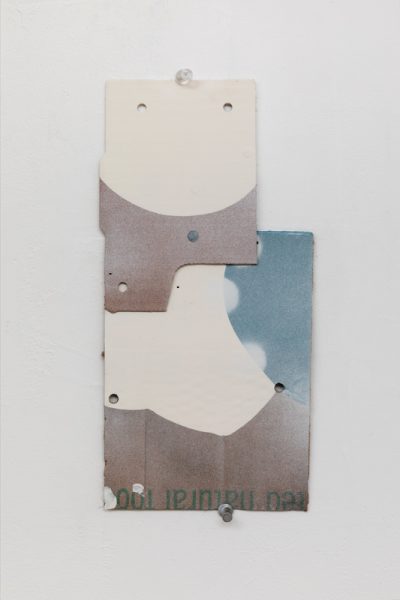
"Message Chair" by George Negroponte, 2016. Enamel, latex and spray paint on cardboard, 0 1/2 x 5 inches. Courtesy of the artist.
.
PR: Does this mean smoother sailing ahead for your art making?
GN: Who knows? My son came back from Sweden with a tee shirt that has a Franz Kafka quote: “If you see light at the end of the tunnel be sure it’s not a train.”
HAH: Funny. It's a bit dark, though.
GN: Well, maybe not, because it’s cautionary, too. I’ve worked my entire life to learn a few things and that list isn’t that long. Making art is like getting clued in at a certain moment. It could be that simple, because for a moment in time you give up on yourself. You take a serious look at what really matters. Then, and only then, something starts to happen and you watch it like an observer. It’s magical because you don’t own it and you don’t control it. You can’t even help having it happen. And for a single, brief moment, you realize you’re free. That helps a lot.
______________________________________
BASIC FACTS: George Negroponte is based in East Hampton, N.Y. To see more of his art, visit www.georgenegroponte.com.
George Neogroponte and Virva Hinnemo both have art exhibited in the group show "Black & White: Modern and Contemporary Positions" at Jason McCoy Gallery in New York City. The show is on view September 14 - October 22, 2016. "George Negroponte: Gravel Road" is exhibited at Anita Rogers Gallery from October 19 to November 30, 2016. The gallery is located at 77 Mercer, Suite 2N, New York, NY 10012. www.anitarogersgallery.com.
______________________________________
Copyright 2016 Hamptons Art Hub LLC. All rights reserved.

